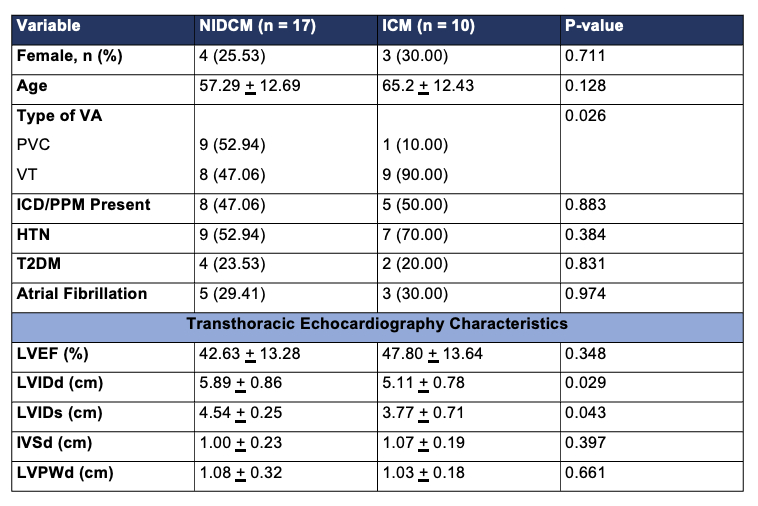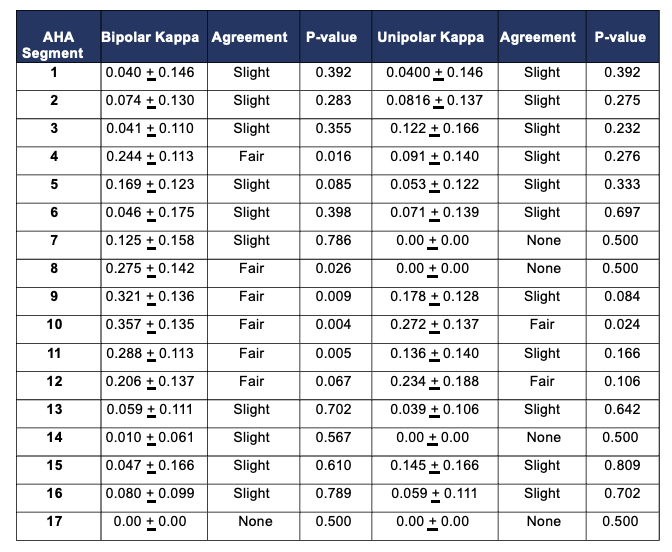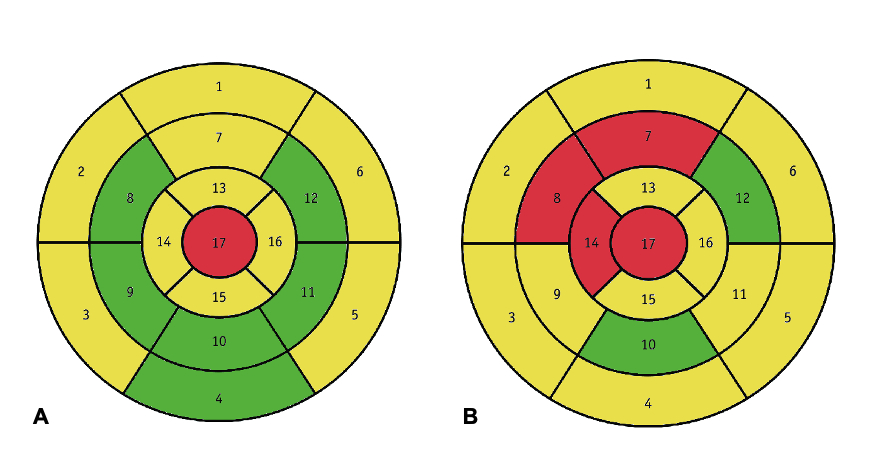Final ID: Su4134
Mapping Ventricular Arrhythmogenic Substrates: Insights from Electroanatomic and Cardiac Magnetic Resonance in Ischemic and Non-Ischemic Cardiomyopathies
Abstract Body (Do not enter title and authors here): Background:
Electroanatomic mapping (EAM) and cardiac magnetic resonance (CMR) identify substrates using parameters from ischemic cardiomyopathy (ICM). CMR's application to characterize scar in non-ischemic dilated cardiomyopathy (NIDCM) is limited.
Objective: To assess scar burden and patterns in patients with VA and NIDCM or ICM and the concordance between CMR and EAM.
Methods:
We reviewed 27 patients with VA ablations (NIDCM and ICM) and prior CMR. ARVC, HCM and infiltrative diseases were excluded. Scar type and morphology were classified (table 2). Myocardial late gadolinium enhancement (LGE) (> 2SD or 3SD) and T1 values were compared to remote myocardium. EAM defined bipolar scar <1.5 mV and unipolar scar <8.3 mV. Scar locations were assigned using the AHA 17-segment model. Cohen’s Kappa coefficient was used to assess categorical agreement of scar severity between CMR and EAM (table 4).
Results:
Scar distribution in NIDCM was predominant in the mid-myocardial septum and ICM in the sub-endocardium (p <0.001). ICM patients had higher presence of posteromedial papillary muscle scar (p=0.001). The difference in myocardial T1 values at the mid-chamber and mid-septum was not significant, likely influenced by the mid-LV chamber short axis cut. The right ventricle was dilated with reduced function and non-compacted myocardium was thicker in NIDCM. Bipolar scar was predominant in AHA segments 1-3 and 9-10 for NIDCM patients and AHA segments 3-12 in ICM patients. AHA segments 4 and 8-12 had fair correlation between bipolar EAM and CMR. Unipolar mapping showed slight agreement in segments 1-6, 9, 11, 13, 15 and 16.
Conclusions:
Scar is predominant in the mid-myocardial septum in NIDCM compared to subendocardial location in ICM. Comparing CMR, EAM at best correlate fairly to midventricular segments in bipolar map slightly to most segments in unipolar map. Improved mapping tools will likely improve ablation success.
Electroanatomic mapping (EAM) and cardiac magnetic resonance (CMR) identify substrates using parameters from ischemic cardiomyopathy (ICM). CMR's application to characterize scar in non-ischemic dilated cardiomyopathy (NIDCM) is limited.
Objective: To assess scar burden and patterns in patients with VA and NIDCM or ICM and the concordance between CMR and EAM.
Methods:
We reviewed 27 patients with VA ablations (NIDCM and ICM) and prior CMR. ARVC, HCM and infiltrative diseases were excluded. Scar type and morphology were classified (table 2). Myocardial late gadolinium enhancement (LGE) (> 2SD or 3SD) and T1 values were compared to remote myocardium. EAM defined bipolar scar <1.5 mV and unipolar scar <8.3 mV. Scar locations were assigned using the AHA 17-segment model. Cohen’s Kappa coefficient was used to assess categorical agreement of scar severity between CMR and EAM (table 4).
Results:
Scar distribution in NIDCM was predominant in the mid-myocardial septum and ICM in the sub-endocardium (p <0.001). ICM patients had higher presence of posteromedial papillary muscle scar (p=0.001). The difference in myocardial T1 values at the mid-chamber and mid-septum was not significant, likely influenced by the mid-LV chamber short axis cut. The right ventricle was dilated with reduced function and non-compacted myocardium was thicker in NIDCM. Bipolar scar was predominant in AHA segments 1-3 and 9-10 for NIDCM patients and AHA segments 3-12 in ICM patients. AHA segments 4 and 8-12 had fair correlation between bipolar EAM and CMR. Unipolar mapping showed slight agreement in segments 1-6, 9, 11, 13, 15 and 16.
Conclusions:
Scar is predominant in the mid-myocardial septum in NIDCM compared to subendocardial location in ICM. Comparing CMR, EAM at best correlate fairly to midventricular segments in bipolar map slightly to most segments in unipolar map. Improved mapping tools will likely improve ablation success.
More abstracts on this topic:
A RETROSPECTIVE EVALUATION OF RESOURCE UTILIZATION AND OUTCOMES IN PATIENTS USING MOBILE ECG DEVICES FOLLOWING ABLATION FOR ATRIAL FIBRILLATION
Fairman Alix, Loh Alexander, Druml Lauren, Triplett Cynthia, Liu Taylor, Pursnani Seema
A novel ECG algorithm using stepwise approach for accurate localization of premature ventricular contraction and ventricular tachycardia: SMART-PVC/VTKhalaph Moneeb, Lucas Philipp, Sciacca Vanessa, Beyer Sebastian, Moersdorf Maximilian, Sohns Christian, Guckel Denise, Sommer Philipp, Trajkovska Nadica, Deneke Thomas, Didenko Maxim, El Hamriti Mustapha, Imnadze Guram, Fink Thomas, Braun Martin, Bergau Leonard



